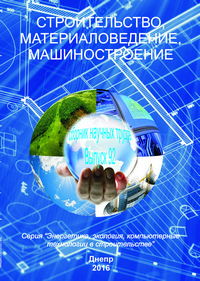Induced thermally conductive channel influence on the formation of the insulating properties of binary composite materials
Keywords:
composite, effective thermal conductivity, Monte Carlo method, induced heat-conducting channels, dark matrixAbstract
Abstract. Purpose. Analysis of accidental placed inclusions impact on efficient thermal conductivity and local heat fluxes of two-phase composite materials. Method. Composite phase placement simulation by the Monte Carlo method, numerical solution of heat equation in a heterogeneous environment, local heat fluxes calculation. Results. The authors have studied the statistical distribution of the effective thermal conductivity and concentration dependences of its average value. Numerical experiments revealed that the twophase composites effective heat conduction and its irremovable variation depends on the inclusions placement options in particular by the minimum possible distance between them. The local heat fluxes maps study is showed that the heat-conducting channels in matrix phase are induced under the influence of external temperature gradient and randomly scattered inclusions. It found that the shielded regions (so-called ―dark matrix‖) appear in composite matrix. The dark matrix local heat fluxes density is comparable to the density of fluxes through the thermal insulation inclusions. Scientific novelty. As a result, the calculations showed that the two-phase materials effective thermal conductivity with insulating inclusions are largely determined by the number and length of the heatconducting channels which are induced in matrix by the external temperature difference. It was also found that the heat-conducting matrix certain volume, which is shielded by inclusions, does not affect on the heat transfer process. Practical meaningfulness. The numerical study allowed us to identify the factors that must be considered in the further development of the generalized conductivity theory for random inhomogeneous composite materials.References
Zarubin V.S., Kuvyrkin G.N. Dvustoronnie ocenki termicheskogo soprotivleniya neodnorodnogo tverdogo tela [Bilateral evaluations of thermal resistance of a non-homogeneous solid]. TVT [High Temperature]. 2013, vol. 51, no. 4, pp. 578-585. (in Russian).
Formalev V.F., Kolesnik S.A. Metodologiya resheniya obratnyh koehfficientnyh zadach po opredeleniyu teplofizicheskih harakteristik anizotropnyh tel [The inverse coefficient problems solution methodology for anisotropic body’s thermal characteristics determination]. TVT [High Temperature]. 2013, vol. 51, no. 6, pp. 875-883. (in Russian).
Bensoussan A. Asymptotic analysis for periodic structures providence. R. I.: American Math. Society, 2011, 392 p.
Fielder T., Pesetskaya E., Öchsner A. and Grácio J. Calculations of the Thermal Conductivity of Porous Materials. Materials Science Forum. 2006, vols. 514 – 516, pp. 754 -758.
Fielder T., Öchsner A., Muthubandara N., Belova I.V. and Murch G.E. Calculation of the effective thermal conductivity in composites using finite element and Monte Carlo methods. Materials Science Forum. 2007, vol. 553, pp. 51-56.
Lobur M., Farmaga I., Marikutsa U., Matviykiv O., Ciupinski L. Analysis and problem statement of the optimal thermal design of technical objects. Proc. of the International Conference Microtechnology and Thermal. Lodz, Poland. June 28- July 1, 2011, pp. 223-227.
Xu Y., Kinugava J., Yaki K. Development of thermal conductivity prediction system for composites. Mater. Trans. 2003, vol. 44, no. 4. pp. 629-632.
Downloads
Published
Issue
Section
License
Редакція Видання категорично засуджує прояви плагіату в статтях та вживає всіх можливих заходів для його недопущення. Плагіат розглядається як форма порушення авторських прав і наукової етики.
При виявлені у статті більш ніж 25% запозиченого тексту без відповідних посилань та використання лапок, стаття кваліфікується як така, що містить плагіат. У цьому випадку стаття більше не розглядається редакцією, а автор отримує перше попередження.
Автори, в статтях яких повторно виявлено плагіат, не зможуть публікуватися в усіх журналах Видавництва ДВНЗ «Придніпровська державна академія будівництва та архітектури».
Автори, які публікуються у цьому журналі, погоджуються з наступними умовами:
- Автори залишають за собою право на авторство своєї роботи та передають журналу право першої публікації цієї роботи на умовах ліцензії Creative Commons Attribution License, котра дозволяє іншим особам вільно розповсюджувати опубліковану роботу з обов'язковим посиланням на авторів оригінальної роботи та першу публікацію роботи у цьому журналі.
- Автори мають право укладати самостійні додаткові угоди щодо неексклюзивного розповсюдження роботи у тому вигляді, в якому вона була опублікована цим журналом (наприклад, розміщувати роботу в електронному сховищі установи або публікувати у складі монографії), за умови збереження посилання на першу публікацію роботи у цьому журналі.
- Політика журналу дозволяє і заохочує розміщення авторами в мережі Інтернет (наприклад, у сховищах установ або на особистих веб-сайтах) рукопису роботи, як до подання цього рукопису до редакції, так і під час його редакційного опрацювання, оскільки це сприяє виникненню продуктивної наукової дискусії та позитивно позначається на оперативності та динаміці цитування опублікованої роботи (див. The Effect of Open Access).

